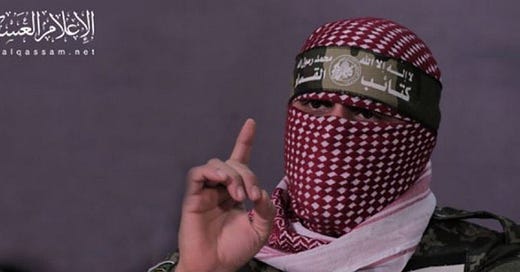Notes on the News
The New York Times versus Le Figaro on the wacky things Hamas says
I belong to a small email list of the world’s few remaining liberal-minded journalists. We’ve been discussing Israel’s rules of engagement, civilian casualties in Gaza, and the efflorescence of repulsive articles like this one in The New York Times and this one from the AP: Israel’s military campaign in Gaza seen as among the most destructive in history, experts say. (They quietly edited it after publishing it, adding the word “recent” before “history.” No correction, no apology.)1
There’s something truly sinister about these flamboyant displays of journalistic bad faith. Jonathan Spyer, the British-Israeli journalist and editor of Middle East Quarterly, wrote the comments below. I asked him for permission to publish them because he’s personally seen how the US and its allies fought a similar war, and I thought his perspective important:
I don’t think that the IDF’s methods and practices, nor the results, differ at all really from those of Western armies operating in similar environments. What differs is media and public attention, that’s all. This attention exists for reasons independent of the military picture.
I covered the anti-ISIS battles in Mosul and Raqqa, and am seeking to cover the current war as closely as I can. I was in Shajaiya with IDF forces last week. The tactics being employed are clearly directly comparable. The pace is similar, too. The conquest of Mosul took nine months. That of Raqqa, a significantly smaller city, took four months. Ron Ben-Yishai, the most serious of Israel’s military correspondents, estimates that of the 20,000 or so dead in Gaza, 7-9,000 were Hamas fighters. If this is accurate (And Ben-Yishai is very far from being a propagandist), then the casualty rate of fighter to civilian in Gaza is 1:1. In Mosul, figures for ISIS military dead range from 7,000-25,000, civilian dead from 6,000-40,000. In Raqqa, figures from Amnesty International and Airwars estimate 1,600 civilians, 1,400 fighters.
For what it’s worth, in my own view, the casualty figures in Mosul and Raqqa are likely considerably higher. In Raqqa I saw mass graves of civilians killed in Coalition bombing and hastily buried by ISIS. No one, to my knowledge, has bothered, in either city, to do a meticulous check of missing civilians using the population register. This is because ISIS didn’t have a large number of powerful states, individuals, and NGOs that cared deeply about it the way Hamas does. So those killed in the course of the destruction of ISIS were just written off. Israel operates in a far less advantageous and sympathetic diplomatic and political environment than do powerful Western states. But this is the only significant difference.
If you want to take a city (or exercise control over it), you can do it in various ways. You can do it the way Bashar Assad did when he took eastern Aleppo in 2016-17, or Putin when he took Grozny in 1999; i.e., by using standoff artillery fire and airpower to obliterate it. You can do it (or at least you can operate) the way that the US, we’re told, has recommended Israel operate, by air power and pinpointed special forces raids. Or you can move a large combined arms force in, after softening up targets using artillery and air power. That’s what the Coalition did to ISIS’s cities, and that’s what Israel is doing in northern Gaza.
The general picture is reminiscent of what the Coalition and its allies did in the ISIS war. So is the decision not to make a headlong rush to plant the flag in the city center (the way the Russians did in the opening phase of the Ukraine war), but rather to move methodically, concentrate on force protection, seek to envelope areas of opposition, then move slowly toward and through them, thus making the enemy appear when you want him to and surrender or be destroyed.
Israel’s goal in Gaza is to destroy a political authority, not intimidate it or punish it (as it sometimes does with the Palestinian Authority in the West Bank), and not to harm the civilian populace (Assad and Putin, obviously, were indifferent to that consideration). In this regard, its war aim is similar to that of the Coalition in the ISIS war, and these methods reflect that.
A major difference I’ve noticed is that the IDF is using combined arms methods in a much better and more integrated way than the Iraqis did in Mosul (in Raqqa, the SDF lacked heavy armor and combat engineering capacities, so it was less of an issue). In Mosul, the Iraqis did a poor job of integrating infantry and armor, with the result that these elements were often used in isolation from one another. If I rightly recall, this resulted, for example, in the 9th Armored Division getting itself stuck and under siege in the city at one point during the battle, because it had gone forward without infantry support. The CTS [Counter Terrorism Service, an Iraqi special ops force] on the other hand, lacking armored support, hemorrhaged men when taking targets in buildings that a tank could have destroyed with a couple of shells. In Shajaiya, I saw the 36th Division’s tanks and infantry working well and methodically together. I have spoken with people from other formations who confirmed this picture.
The fight in the south is likely to be different. There is a large civilian population there. The Israeli hostages and the Hamas leadership are probably there, too. The Division tasked with the job, the 98th, is an airborne and commando formation, specializing in focused operations, and the combat is likely to reflect all these elements.
Keep reading with a 7-day free trial
Subscribe to The Cosmopolitan Globalist to keep reading this post and get 7 days of free access to the full post archives.





